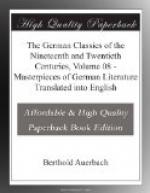In the characters of the great sovereigns of the eighteenth century, who created new, stricter, more regular forms of government, the same contrast appears between personal arbitrariness and devotion to this universal law founded by them. Frederick the Great, Joseph II., Catherine of Russia, Maria Theresa, Charles XII., Peter the Great, could none of them quite escape from the eccentricity which was considered the necessary attribute of genius. They furnished material, therefore, for countless anecdotes; by personal whims, freaks, and caprices they freed themselves at times from the new spirit of social uniformity and political legal equality. One could not reconcile such anecdote-business with the picture of the antique and medieval hero-kings. In the last two centuries, on the contrary, a king had to be witty if his greatness was not to be considered tedious by the people of the Pigtail. The scandalous chronicle of the Courts was at least as important as the political chronicles of the kingdoms. Through his mother-wit and his good jokes Old Fritz became a popular figure even among his adversaries, and among the people outside of Prussia he still lives on today in the anecdotes of his private life rather than in his princely actions. All the kings and heroes of the Rococo age therefore are rather material for the historical genre picture of the novel and the comedy, than for the genuine historical picture of the epic and the tragedy. One can fully characterize them only by painting a hundred individual traits expressive of their peculiarity and their caprice, and this is incompatible with the great epic style. It is by no means accidental that Scherenberg is unable to get away from the most arbitrary crabbed versification in his historical genre poems celebrating Frederick the Great. The capricious heroes with pigtails do not tolerate smooth verses. The favorite verse-form of their day, however, the stiff alexandrine, characterizes the Pigtail exclusively, not the Rococo.
The small princes imitated the great, and what in the latter had been original traits of character, became in the former amusing caricatures. The one copies Peter the Great’s wedding of dwarfs; the other the giant guard of Frederick Wilhelm I. A prince with such a wonderful passion for the bass viol as Duke Maurice of Saxe-Merseburg, who even laid a small bass viol in the cradle of his new-born daughter, was possible only in the eighteenth century. It may be that his subjects did not even call him a fool, but only a man of princely whims. A prince who wields the fiddle-bow instead of the sceptre and thereby keeps his hands “clean from blood and ink atrocities,” is a true representative of the Rococo, not of the Pigtail. That Landgrave of Hesse who wished to create a second Potsdam in Pirmasens, and was made blissful by the thought that he could hold his court in the tobacco-reeking guard-room, who celebrated the greatest triumph of his reign when he had his entire grenadier regiment manoeuvre in the pitch-dark drill-hall without the least disorder occurring in the ranks, he is a real Rococo figure, for by his mad fancies he humorously destroyed the long pigtail appended to his actions.




